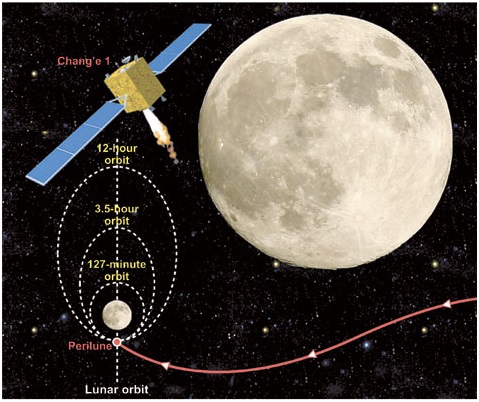The Chinese Lunar Exploration Program (A.K.A. the Chang'e program) is a Chinese space program that has utilized and will utilize lunar orbiters, lunar landers, lunar rovers and lunar sample returners to explore the Moon. Chang'e is a Chinese lunar goddess. Ouyang Ziyuan is the chief scientist of the program. He is one of the first Chinese scientists to advocate exploitation of lunar helium-3 for future nuclear fusion reactors.
The first mission for the Chang'e program was the Chang'e 1 lunar orbiter, launched on a Long March 3A rocket from the Xichang Satellite Launch Center in late October of 2007. During a twelve day trip to the Moon, the orbiter analyzed the solar wind between the Earth and the Moon. It entered a one hundred and twenty mile lunar orbit in early November of 2007 and began sending pictures back to earth. A map of the entire lunar surface was constructed from Chang'e 1 pictures taken between November 2007 and July 2008. The 3-D map from Chang'e 1 was the most detailed such map yet created of the lunar surface. In addition to helium-3, the orbiter analyzed locations and abundance of aluminum, calcium, chromium, lanthanum, magnesium, manganese, oxygen, potassium, silicon, sodium, uranium, tellurium, thorium and titanium. Many of these elements are important for manufacturing. In early 2009, the orbiter was taken out of lunar orbit and deliberately crashed into the surface of the Moon.
A second lunar obiter, the Chang'e 2, was launched on October 2010 on a Long March 3C rocket. This satellite assumed a sixty mile orbit above the surface of the Moon after a five day travel time. The Chang'e 2 contained equipment similar to the Chang'e 1 instrument package with a few improvements and additions including a more accurate altimeter and a higher resolution camera. The map produced by the Chang'e 2 was more detailed and accurate than that produced by the Chang'e 1. One of the primary objectives of the Chang'e 2 mission was to assist in the choice of a landing site for the planned Chang'e 3 lunar orbiter, lander and rover launch in late 2013. The Chang'e 2 left lunar orbit in June of 2011 and flew to the second Earth-Sun Lagrangian point to test navigation. The L-2 point is a position beyond the orbit of the Earth where the gravity of the Earth just balances the additional orbital velocity of an object with a larger solar orbit. The bottom line is that an object in that location should maintain its relative position indefinitely as the Earth moves around the Sun. The Chang'e 2 then left L-2 and flew past an asteroid named 4179 Toutatis, taking high resolution pictures. The Chang'e 2 continued on into deep space.
The Chang'e 1 and Chang'e 2 constituted the first phase of Chinese lunar exploration. This phase consisted of satellites that just orbited the Moon. The second phase consistes of lunar landers and rovers. The third phase will include taking samples of the lunar surface and returning them to Earth.
Chang'1 and orbit:
